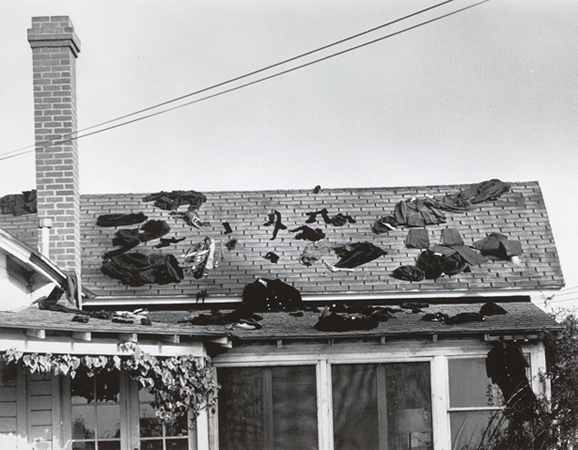Bas Jan Ader: Tra due mondi
January 24–March 17, 2013
Villa delle Rose
via Saragozza 228/230 Bologna
Curated by Javier Hontoria
Bas Jan Ader. Tra due mondi is the first retrospective dedicated to Bas Jan Ader in Italy. The title alludes to the condition of being constantly in transit, between the Old and New World, between the subjectivity inherent to the romantic drift and cold impersonality of Conceptual Art, between the extreme rationalism of Mondrian and the vibrant absurdity of slapstick comedy.
Born in 1942 in the Netherlands, Bas Jan Ader was a unique figure in the art of 1960s and ’70s. In 1975, he was lost at sea while attempting to reach Ireland aboard a small 4-metre-long boat. The exhibition explores the relationship between man and nature, interpreted by Ader from a Romantic viewpoint; it also focuses on the concept of melancholy, one that finds its roots in the humanist tradition. Simultaneously, it features constant references to his fellow countryman Piet Mondrian while giving shape to an existentialist drive. It is under this light that his famous “falls” emerge, a topic that stands close to the legacy of authors like Camus or Beckett, the American slapstick comedy of the 1920s and the work of those that took failure and the absurd as their central themes. Ader is also one of the most original figures to have re-drafted the essential features of Conceptual Art, thrusting aside its formal aridity in favour of a more personal and evocative language.
Bas Jan Ader. Tra due mondi analyses the main Ader’s phases as an artist and features six thematic sections.
Melancholy and Romanticism
Bas Jan Ader’s affinity to some of the postulates of the Romantic tradition is a recurring theme in his career. For example, the sense of solitary subjectiveness of the individual within the immeasurable and incomprehensible context of nature is clearly expressed in Farewell to faraway friends, a work that evokes Caspar David Friedrich’s Monk by the sea. Ader was also interested in melancholia, a mental state that was deeply examined by the Neoplatonic scholars of 15th-century Florence and which clearly emerges in The artist as consumer of extreme comfort, a photograph that echoes Dürer’s famous print, Melancholia I.
How to disappear completely
Bas Jan Ader always worked in solitude. However, despite being a reserved and elusive character, he always stood at the very centre of every work. This section presents some works in which the artist explored the duality of presence/absence, a recurring motif throughout his oeuvre. The film Nightfall and the photographs of (Untitled) Tea Party are good examples of this interest.
Mondrian’s legacy
As a young artist, Bas Jan Ader studied Mondrian in depth. Mondrian completely rejected diagonal lines in a radical attempt to rationalise ideas and reality. This theme was picked up by Ader in some of his most famous “falls”: Broken fall (geometric), Westkapelle, Holland shows the artist falling flat on the ground after a diagonal trajectory, with the Westkapelle lighthouse in the background. Through the falls related to Mondrian, Ader addresses the failure of the modernist project of which the Dutch master was a leading figure.
Language and theatre
Language was one of the most important and most widely used strategies in the 1960s in both Europe and the United States. Many artists interpreted it from a tautological and self-referential point of view, making the word the subject/object of their works. Bas Jan Ader took the opposite point of view, using language subjectively to convey his personal anxieties. A good example is his widely-acclaimed Please don’t leave me, a phrase which was written on a wall, then photographed and finally erased.
I’m too sad to tell you
Considered by many to be one of Bas Jan Ader’s most emblematic work, I’m too sad to tell you is as magnetic as it is enigmatic. The film shows the artist in the foreground, crying in front of the camera. We do not know why he is crying, and the title of the work itself clearly expresses his intention to hide his reasons. It is one of the works that best represents Ader’s personal and poetic contribution to Conceptual Art.
Falling
The existentialist and simultaneously comic mood typifying Bas Jan Ader’s spirit finds its clearest expression in his falls. The three films screened here—Broken fall (organic), Amsterdamse Bos, Holland; Fall I, Los Angeles; Fall II Amsterdam—only depict Bas Jan Ader falling, becoming the visual depictions of the very concept of falling, without any reference to causes and consequences. As has been often described, these films evoke the fall of the hero in Greek tragedy and, at the same time, recall the slapstick of Keaton and Chaplin.
Bas Jan Ader. Tra due mondi is organised by MAMbo – Museo d’Arte Moderna di Bologna in collaboration with Museum Boijmans Van Beuningen, with the support of the Embassy of the Kingdom of the Netherlands in Rome and KLM.
The exhibition is part of ART CITY Bologna 2013, the cultural programme promoted by Comune di Bologna and BolognaFiere on the occasion of Arte Fiera 2013.


